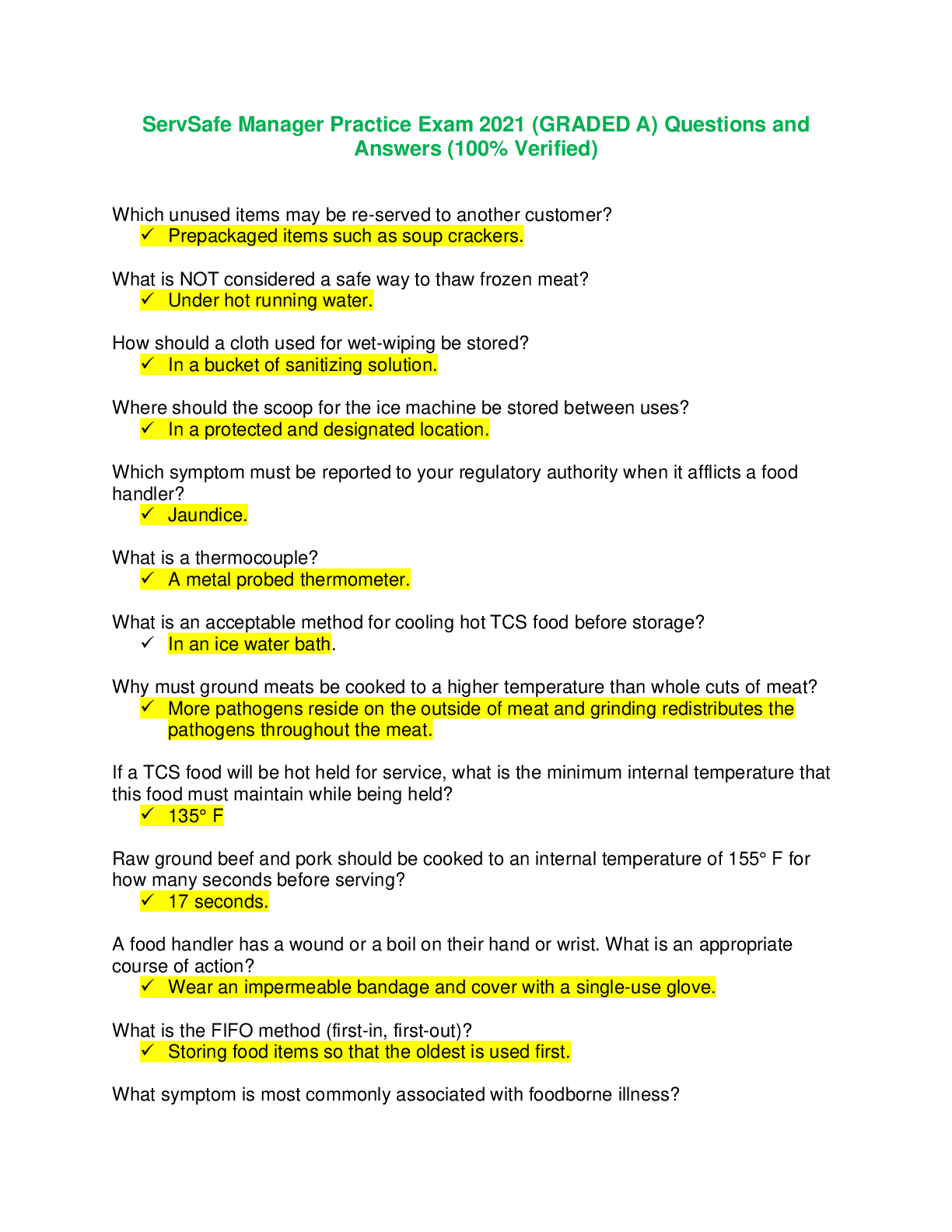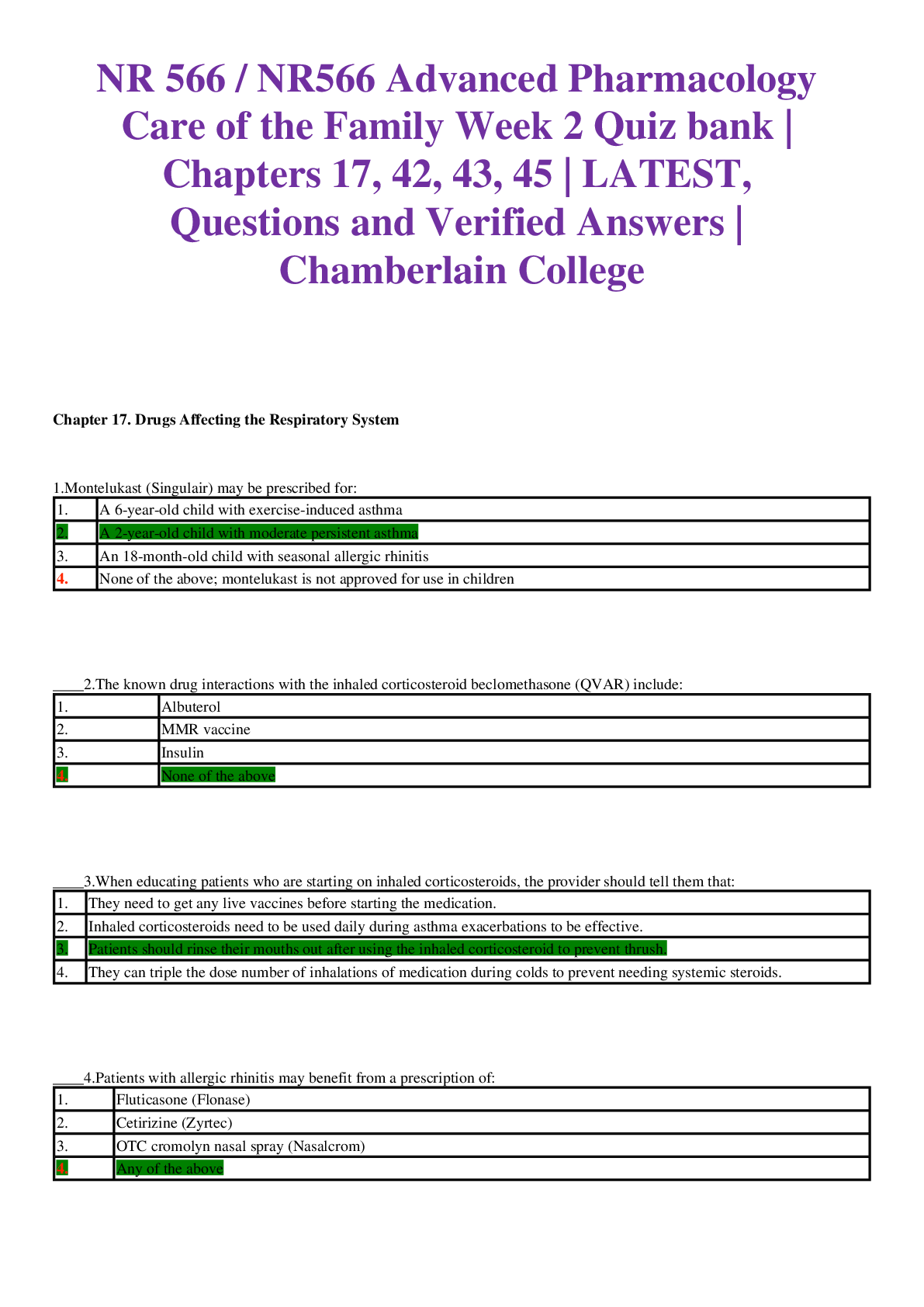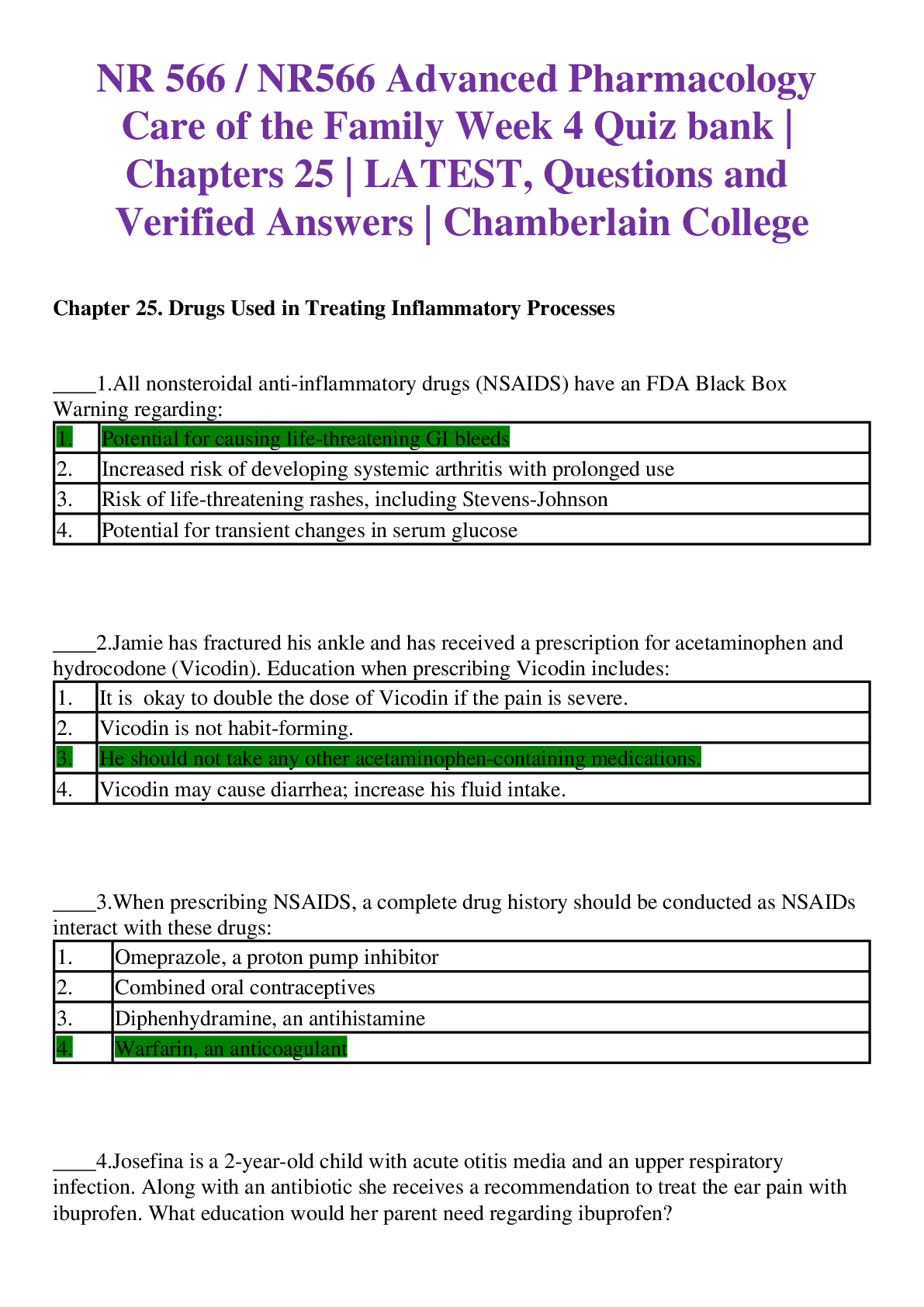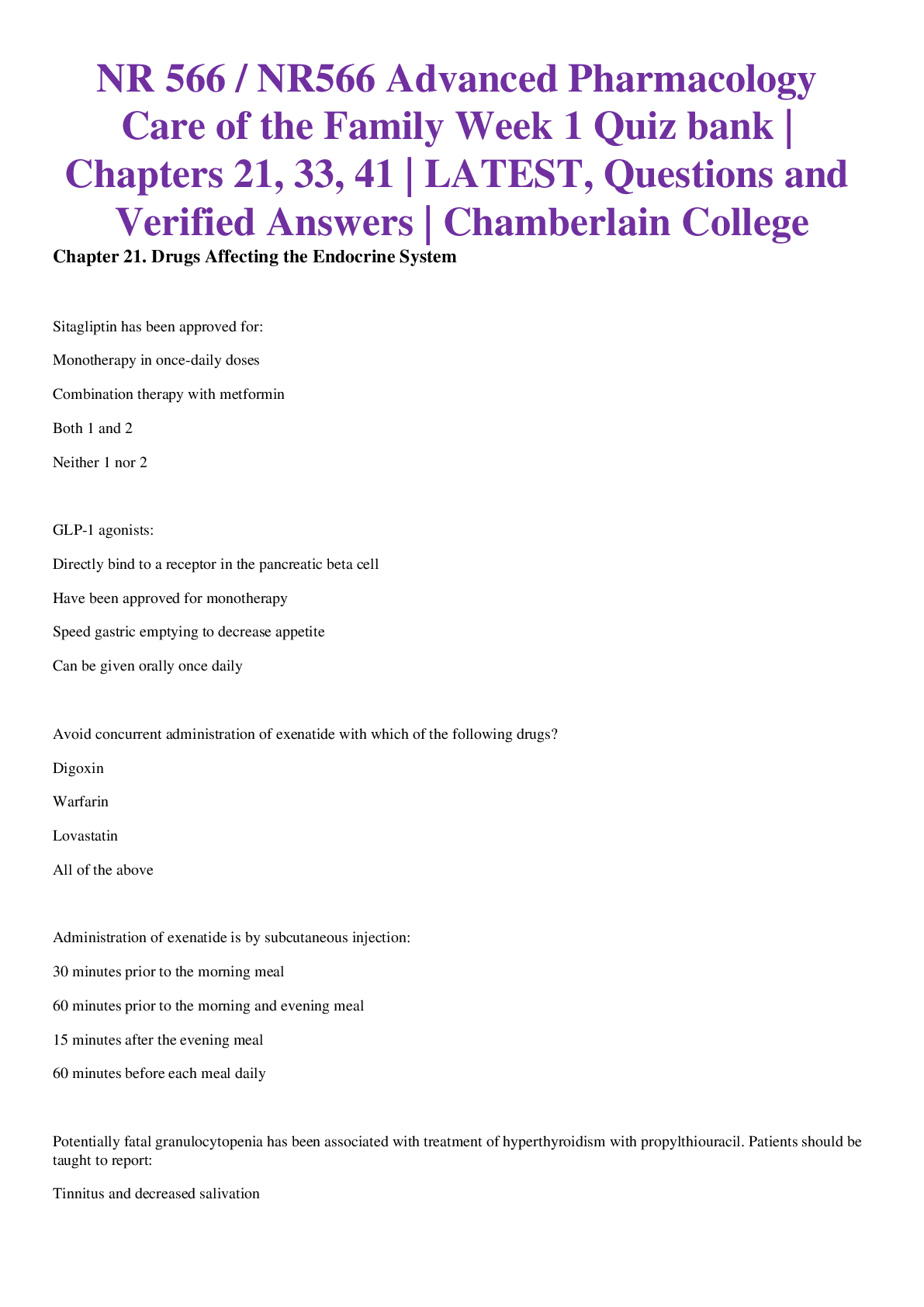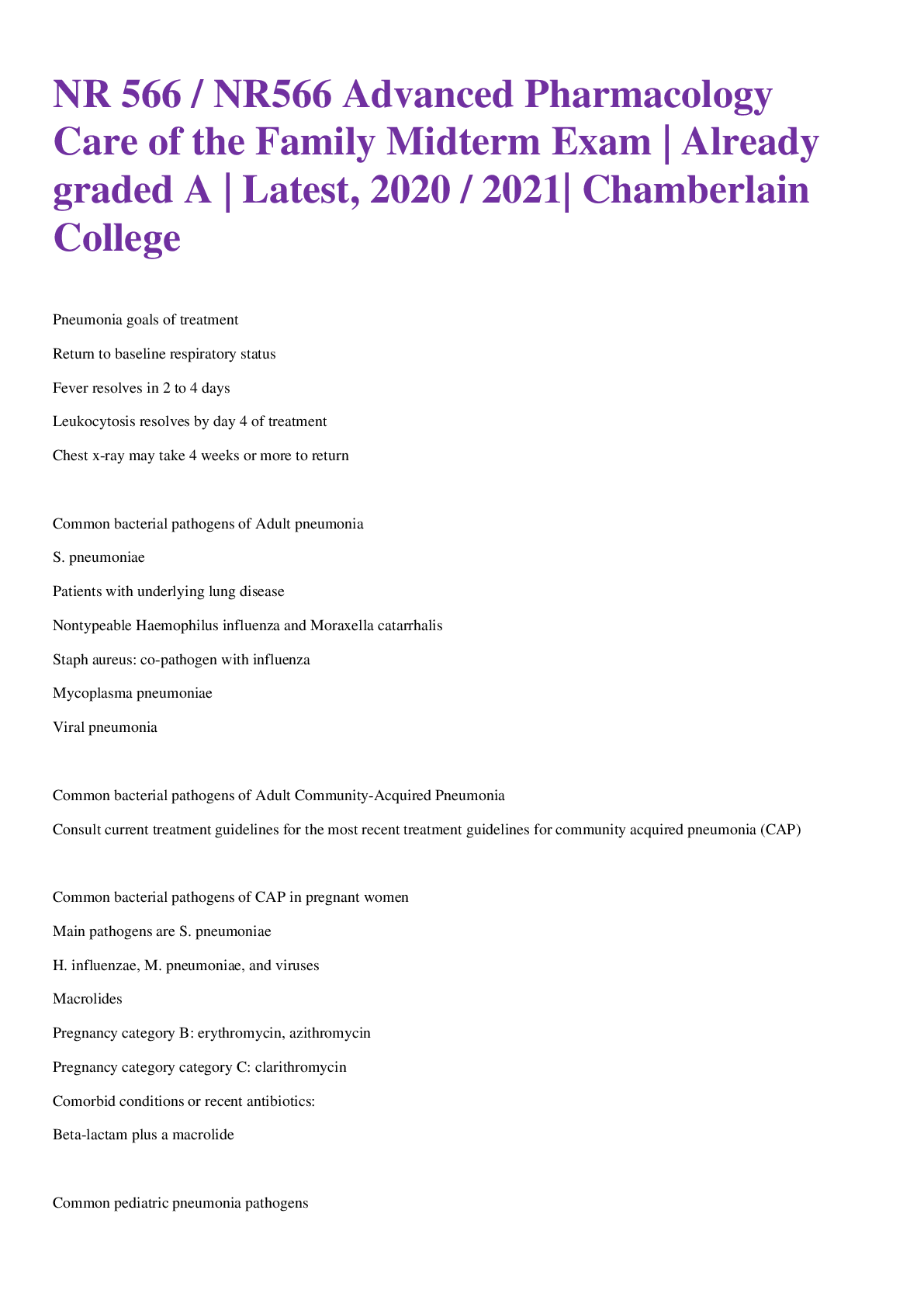*NURSING > EXAM > Nursing Care of the Family During Pregnancy Perry: Maternal Child Nursing Care, 6th Edition | DETAIL (All)
Nursing Care of the Family During Pregnancy Perry: Maternal Child Nursing Care, 6th Edition | DETAILED SOLUTION 100%
Document Content and Description Below
Chapter 08: Nursing Care of the Family During Pregnancy Perry: Maternal Child Nursing Care, 6th Edition MULTIPLE CHOICE 1. The nurse caring for a newly pregnant woman would advise her that id... eally prenatal care should begin: a. before the first missed menstrual period. b. after the first missed menstrual period. c. after the second missed menstrual period. d. after the third missed menstrual period. 2. Prenatal testing for human immunodeficiency virus (HIV) is recommended for: a. all women, regardless of risk factors. b. a woman who has had more than one sexual partner. c. a woman who has had a sexually transmitted infection. d. a woman who is monogamous with her partner. 3. Which symptom is considered a warning sign and should be reported immediately by the pregnant woman to her health care provider? a. Nausea with occasional vomiting b. Fatigue c. Urinary frequency d. Vaginal bleeding 4. A pregnant woman at 10 weeks of gestation jogs three or four times per week. She is concerned about the effect of exercise on the fetus. The nurse should inform her: a. “You don’t need to modify your exercising any time during your pregnancy.” b. “Stop exercising because it will harm the fetus.” c. “You may find that you need to modify your exercise to walking later in your pregnancy, around the seventh month.” d. “Jogging is too hard on your joints; switch to walking now.” 5. The multiple marker test is used to assess the fetus for which condition? a. Down syndrome b. Diaphragmatic hernia c. Congenital cardiac abnormality d. Anencephaly 6. A woman who is 32 weeks’ pregnant is informed by the nurse that a danger sign of pregnancy could be: a. constipation. b. alteration in the pattern of fetal movement. c. heart palpitations. d. edema in the ankles and feet at the end of the day. 7. A woman who is 14 weeks pregnant tells the nurse that she always had a glass of wine with dinner before she became pregnant. She has abstained during her first trimester and would like to know if it is safe for her to have a drink with dinner now. The nurse would tell her: a. “Since you’re in your second trimester, there’s no problem with having one drink with dinner.” b. “One drink every night is too much. One drink three times a week should be fine.” c. “Since you’re in your second trimester, you can drink as much as you like.” d. “Because no one knows how much or how little alcohol it takes to cause fetal problems, the best course is to abstain throughout your pregnancy.” 8. A pregnant woman at 18 weeks of gestation calls the clinic to report that she has been experiencing occasional backaches of mild-to-moderate intensity. The nurse would recommend that she: a. do Kegel exercises. b. do pelvic rock exercises. c. use a softer mattress. d. stay in bed for 24 hours. 9. A woman is 3 months pregnant. At her prenatal visit, she tells the nurse that she does not know what is happening; one minute she’s happy that she is pregnant, and the next minute she cries for no reason. Which response by the nurse is most appropriate? a. “Don’t worry about it; you’ll feel better in a month or so.” b. “Have you talked to your husband about how you feel?” c. “Perhaps you really don’t want to be pregnant.” d. “Hormonal changes during pregnancy commonly result in mood swings.” 10. The nurse should be aware that the partner’s main role in pregnancy is to: a. provide financial support. b. protect the pregnant woman from “old wives’ tales.” c. support and nurture the pregnant woman. d. make sure the pregnant woman keeps prenatal appointments. 11. During the first trimester, a woman can expect which of the following changes in her sexual desire? a. An increase, because of enlarging breasts b. A decrease, because of nausea and fatigue c. No change d. An increase, because of increased levels of female hormones 12. Which behavior indicates that a woman is “seeking safe passage” for herself and her infant? a. She keeps all prenatal appointments. b. She “eats for two.” c. She drives her car slowly. d. She wears only low-heeled shoes. 13. A 3-year-old girl’s mother is 6 months pregnant. What concern is this child likely to verbalize? a. How the baby will “get out”? b. What the baby will eat? c. Whether her mother will die? d. What color eyes the baby has? 14. In her work with pregnant women of various cultures, a nurse practitioner has observed various practices that seemed strange or unusual. She has learned that cultural rituals and practices during pregnancy seem to have one purpose in common. Which statement best describes that purpose? a. To promote family unity b. To ward off the “evil eye” c. To appease the gods of fertility d. To protect the mother and fetus during pregnancy 15. What type of cultural concern is the most likely deterrent to many women seeking prenatal care? a. Religion b. Modesty c. Ignorance d. Belief that physicians are evil 16. With regard to a woman’s reordering of personal relationships during pregnancy, the maternity nurse should understand that: a. because of the special motherhood bond, a woman’s relationship with her mother is even more important than with the father of the child. b. nurses need not get involved in any sexual issues the couple has during pregnancy, particularly if they have trouble communicating them to each other. c. women usually express two major relationship needs during pregnancy: feeling loved and valued and having the child accepted by the father. d. the woman’s sexual desire is likely to be highest in the first trimester because of the excitement and because inNteUrcRoSuINrsGeTiBs .pChOyMsically easier. 17. What represents a typical progression through the phases of a woman’s establishing a relationship with the fetus? a. Accepts the fetus as distinct from herself—accepts the biologic fact of pregnancy—has a feeling of caring and responsibility. b. Fantasizes about the child’s gender and personality—views the child as part of herself—becomes introspective. c. Views the child as part of herself—has feelings of well-being—accepts the biologic fact of pregnancy. d. “I am pregnant.”—“I am going to have a baby.”—“I am going to be a mother.” 18. As relates to the father’s acceptance of the pregnancy and preparation for childbirth, the maternity nurse should know that: a. the father goes through three phases of acceptance of his own. b. the father’s attachment to the fetus cannot be as strong as that of the mother because it does not start until after birth. c. in the last 2 months of pregnancy, most expectant fathers suddenly get very protective of their established lifestyle and resist making changes to the home. d. typically men remain ambivalent about fatherhood right up to the birth of their child. 19. With regard to the initial visit with a patient who is beginning prenatal care, nurses should be aware that: a. the first interview is a relaxed, get-acquainted affair in which nurses gather some general impressions. b. if nurses observe handicapping conditions, they should be sensitive and not enquire about them because the patient will do that in her own time. c. nurses should be alert to the appearance of potential parenting problems, such as depression or lack of family support. d. because of legal complications, nurses should not ask about illegal drug use; that is left to physicians. 20. With regard to follow-up visits for women receiving prenatal care, nurses should be aware that: a. the interview portions become more intensive as the visits become more frequent over the course of the pregnancy. b. monthly visits are scheduled for the first trimester, every 2 weeks for the second trimester, and weekly for the third trimester. c. during the abdominal examination, the nurse should be alert for supine hypotension. d. for pregnant women, a systolic blood pressure (BP) of 130 and a diastolic BP of 80 is sufficient to be considered hypertensive. 21. While teaching the expectant mother about personal hygiene during pregnancy, maternity nurses should be aware that: NURSINGTB.COM a. tub bathing is permitted even in late pregnancy unless membranes have ruptured. b. the perineum should be wiped from back to front. c. bubble bath and bath oils are permissible because they add an extra soothing and cleansing action to the bath. d. expectant mothers should use specially treated soap to cleanse the nipples. egrity 22. To provide the patient with accurate information about dental care during pregnancy, maternity nurses should be aware that: a. dental care can be dropped from the priority list because the woman has enough to worry about and is getting a lot of calcium anyway. b. dental surgery, in particular, is contraindicated because of the psychologic stress it engenders. c. if dental treatment is necessary, the woman will be most comfortable with it in the second trimester. d. dental care interferes with the expectant mother’s need to practice conscious relaxation. 23. When discussing work and travel during pregnancy with a pregnant patient, nurses should instruct them that: a. women should sit for as long as possible and cross their legs at the knees from time to time for exercise. b. women should avoid seat belts and shoulder restraints in the car because they press on the fetus. c. metal detectors at airport security checkpoints can harm the fetus if the woman passes through them a number of times. d. while working or traveling in a car or on a plane, women should arrange to walk around at least every 2 hours or so. ANS: D Periodic walking helps prevent thrombophlebitis. Pregnant women should avoid sitting or standing for long periods and crossing the legs at the knees. Pregnant women must wear lap belts and shoulder restraints. The NmUoRstSIcNoGmTmBo.CnOiMnjury to the fetus comes from injury to the mother. Metal detectors at airport security checkpoints do not harm fetuses. PTS: 1 DIF: Cognitive Level: Comprehension OBJ: Nursing Process: Planning MSC: Client Needs: Health Promotion and Maintenance 24. With regard to medications, herbs, shots, and other substances normally encountered by pregnant women, the maternity nurse should be aware that: a. both prescription and over-the-counter (OTC) drugs that otherwise are harmless can be made hazardous by metabolic deficiencies of the fetus. b. the greatest danger of drug-caused developmental deficits in the fetus is seen in the final trimester. c. killed-virus vaccines (e.g., tetanus) should not be given during pregnancy, but live-virus vaccines (e.g., measles) are permissible. d. no convincing evidence exists that secondhand smoke is potentially dangerous to the fetus. 25. Which statement about multifetal pregnancy is inaccurate? a. The expectant mother often develops anemia because the fetuses have a greater demand for iron. b. Twin pregnancies come to term with the same frequency as single pregnancies. c. The mother should be counseled to increase her nutritional intake and gain more weight. d. Backache and varicose veins often are more pronounced. 26. The phenomenon of someone other than the mother-to-be experiencing pregnancy-like symptoms such as nausea and weight gain applies to the: a. mother of the pregnant woman. b. couple’s teenage daughter. c. sister of the pregnant woman. d. expectant father. 27. In response to requests by the U.S. Public Health Service for new models of prenatal care, an innovative new approach to prenatal care known as centering pregnancy was developed. Which statement would accurately apply to the centering model of care? a. Group sessions begin with the first prenatal visit. b. At each visit, blood pressure, weight, and urine dipsticks are obtained by the nurse. c. Eight to twelve women are placed in gestational-age cohort groups. d. Outcomes are similar to those of traditional prenatal care. PTS: 1 DIF: Cognitive Level: Application OBJ: Nursing Process: Implementation MSC: Client Needs: Health Promotion and Maintenance 28. While you are assessing the vital signs of a pregnant woman in her third trimester, the patient complains of feeling faint, dizzy, and agitated. Which nursing intervention is appropriate? a. Have the patient stand up and retake her blood pressure. b. Have the patient sit down and hold her arm in a dependent position. c. Have the patient lie supine for 5 minutes and recheck her blood pressure on both arms. d. Have the patient turn to her left side and recheck her blood pressure in 5 minutes. MULTIPLE RESPONSE 1. Signs and symptoms that a woman should report immediately to her health care provider include: (Select all that apply.) a. vaginal bleeding. b. rupture of membranes. c. heartburn accompanied by severe headache. d. decreased libido. e. Urinary frequency. ANS: A, B, C Vaginal bleeding, rupture of membranes, and severe headaches all are signs of potential complications in pregnancy. Patients should be advised to report these signs to the health care provider. Decreased libido and urinary frequency are common discomforts of pregnancy that do not require immediate health care interventions. PTS: 1 DIF: Cognitive Level: Analysis OBJ: Nursing Process: Planning, Implementation MSC: Client Needs: Physiologic Integrity 2. A woman has just moved to the United States from Mexico. She is 3 months pregnant and has arrived for her first prenatal visit. During her assessment interview, you discover that she has not had any immunizations. Which immunizations should she receive at this point in her pregnancy? (Select all that apply.) a. Tetanus b. Diphtheria c. Chickenpox d. Rubella e. Hepatitis B ANS: A, B, E Immunization with live or attenuated live viruses is contraindicated during pregnancy because of potential teratogenicity. Vaccines consisting of killed viruses may be used. Immunizations that may be administered during pregnancy include tetanus, diphtheria, recombinant hepatitis B, and rabies vaccines. Live-virus vaccines include those for measles (rubeola and rubella), chickenpox, and mumps. PTS: 1 DIF: Cognitive Level: Analysis OBJ: Nursing Process: Implementation MSC: Client Needs: Health Promotion and Maintenance COMPLETION 1. A woman arrives at the clinic for a pregnancy test. The first day of her last menstrual period (LMP) was September 10, 2013. Her expected date of birth (EDB) would be? NURSINGTB.COM ANS: June 17, 2014 Using Nägele’s rule, June 17, 2014, is the correct EDB. The EDB is calculated by subtracting 3 months from the first day of the LMP and adding 7 days + 1 year to the day of the LMP. Therefore, with an LMP of September 10, 2013: September 10, 2013 3 months = June 10, 2013 + 7 days = June 17, 2013 + 1 year = June 17, 2014 PTS: 1 DIF: Cognitive Level: Knowledge OBJ: Nursing Process: Assessment MSC: Client Needs: Health Promotion and Maintenance MATCHING All pregnant women should be instructed to recognize and report potential complications for each trimester of pregnancy. Match the sign or symptom with a possible cause. a. Severe vomiting in early pregnancy b. Epigastric pain in late pregnancy c. Severe backache and flank pain d. Decreased fetal movement e. Glycosuria 1. Fetal jeopardy or intrauterine fetal death 2. Kidney infection or stones 3. Gestational diabetes 4. Hyperemesis gravidarum 5. Hypertension, preeclampsia 1. ANS: D PTS: 1 DIF: Cognitive Level: Comprehension OBJ: Nursing Process: Implementation MSC: Client Needs: Health Promotion and Maintenance NOT: It is essential for the nurse to plan education needed by the pregnant woman to recognize and report these potential complications a timely manner. A trusting relationship contributes to a positive outcome for the pregnancy. 2. ANS: C PTS: 1 DIF: Cognitive Level: Comprehension OBJ: Nursing Process: Implementation MSC: Client Needs: Health Promotion and Maintenance NOT: It is essential for the nurse to plan education needed by the pregnant woman to recognize and report these potential complications a timely manner. A trusting relationship contributes to a positive outcome for the pregnancy. 3. ANS: E PTS: 1 DIF: Cognitive Level: Comprehension OBJ: Nursing Process: Implementation MSC: Client Needs: Health Promotion and Maintenance NOT: It is essential for the nurse to plan education needed by the pregnant woman to recognize and report these potential complications a timely manner. A trusting relationship contributes to a positive outcome for the pregnancy. 4. ANS: A PTS: 1 DIF: Cognitive Level: Comprehension OBJ: Nursing Process: Implementation MSC: Client Needs: Health Promotion and Maintenance NOT: It is essential for the nurse to plan education needed by the pregnant woman to recognize and report these potential complications a timely manner. A trusting relationship contributes to a positive outcome for the pregnancy. 5. ANS: B PTS: 1 DIF: Cognitive Level: Comprehension OBJ: Nursing Process: ImplementaNtioUnRSINMGSTCB.:CCOlMient Needs: Health Promotion and Maintenance NOT: It is essential for the nurse to plan education needed by the pregnant woman to recognize and report these potential complications a timely manner. A trusting relationship contributes to a positive outcome for the pregnancy. [Show More]
Last updated: 2 years ago
Preview 1 out of 13 pages

Buy this document to get the full access instantly
Instant Download Access after purchase
Buy NowInstant download
We Accept:

Reviews( 0 )
$10.00
Can't find what you want? Try our AI powered Search
Document information
Connected school, study & course
About the document
Uploaded On
Apr 05, 2021
Number of pages
13
Written in
Additional information
This document has been written for:
Uploaded
Apr 05, 2021
Downloads
0
Views
120

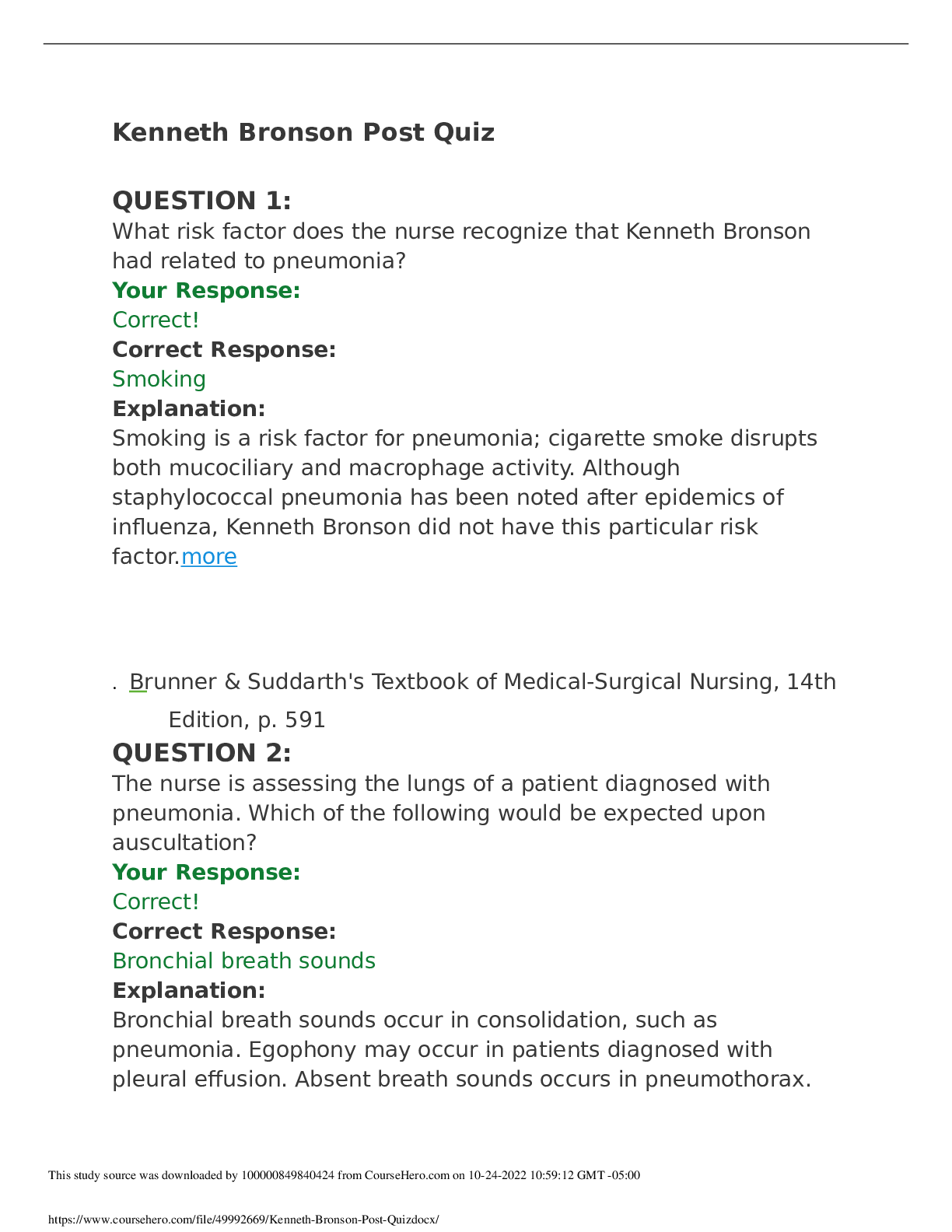

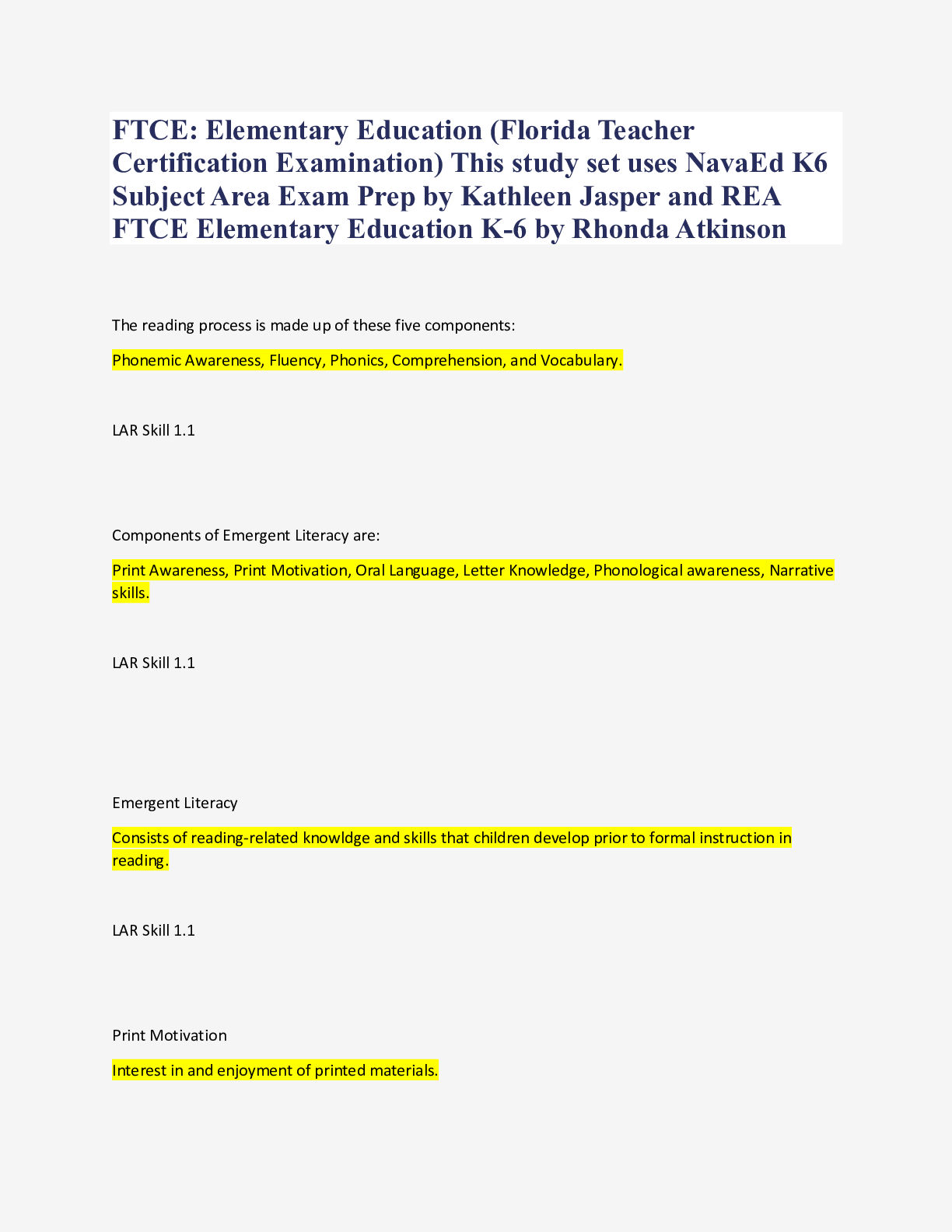

 Questions and Answers 100% VERIFIED.png)
 Questions and Answers 100% correct Solutions.png)



